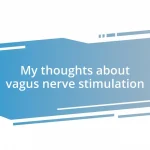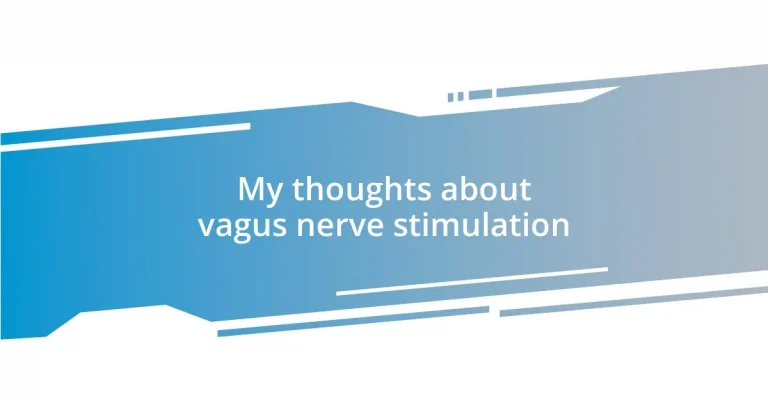Key takeaways:
- The vagus nerve connects the brain to various organs, playing a critical role in regulating stress, emotions, and bodily functions.
- Vagus nerve stimulation can be achieved through methods like deep breathing and mindfulness meditation, leading to benefits such as reduced anxiety and improved mood.
- Despite its benefits, vagus nerve stimulation may cause side effects, including dizziness and voice changes, emphasizing the need for caution and professional guidance.
- Future research on the vagus nerve holds potential for treating various conditions, enhancing healing processes, and integrating with other therapeutic practices.

Understanding the vagus nerve
The vagus nerve is a fascinating part of our nervous system, often overlooked in discussions about health. It stretches from the brainstem down to the abdomen, connecting to various organs, and plays a crucial role in regulating bodily functions. I remember learning about its role in stress management—the way it prompts our body to relax after a stressful situation—and it made me wonder, how many of us actually tap into that natural calming mechanism in our daily lives?
When I first discovered the vagus nerve’s connection to emotional regulation, it struck me how deeply interwoven our physiological and emotional states are. The nerve helps control our heart rate and digestion, linking our minds and bodies in a profound way. I’ve noticed that when I’m mindful of my breath and my emotions, I feel a sense of control over my anxiety—could this be the vagus nerve working its magic in real-time?
What’s truly captivating is the idea that we can influence the vagus nerve through simple practices like deep breathing and meditation. In my own experience, incorporating mindful moments into my day has drastically shifted my mood. Have you ever paused to breathe deeply when stressed and felt your body relax? That’s the vagus nerve responding to your intention, reminding us of its incredible potential to enhance overall well-being.

What is vagus nerve stimulation
The stimulation of the vagus nerve involves methods designed to enhance its function, ultimately influencing our body’s state of relaxation and well-being. I’ve always found it fascinating how this stimulation can take various forms, such as electrical devices implanted in the body or even just simple techniques like deep breathing exercises. It reminds me of the time I experimented with a meditation app that focused on breathing rhythms—it felt like a gentle massage for my nervous system.
In essence, vagus nerve stimulation acts as a bridge between the mind and body, encouraging a state of calm that contrasts sharply with our fast-paced, stress-heavy routines. I recall a particularly hectic week at work, where I dedicated just a few minutes each day to conscious breathwork. The relief and clarity I experienced were profound—almost like hitting a reset button. Have you ever had a moment where it felt like everything just clicked into place? That’s the power of engaging the vagus nerve.
From a clinical perspective, researchers have explored vagus nerve stimulation as a treatment approach for various conditions like anxiety, depression, and even epilepsy. While I’m not a medical professional, I often ponder how an understanding of such a simple yet vital nerve could lead to innovative therapies. What if more people embraced practices that stimulate the vagus nerve? I believe it could foster a movement toward healthier living and emotional resilience.
| Method | Description |
|---|---|
| Electrical Stimulation | Implantable devices that send electrical signals to the vagus nerve. |
| Breathing Exercises | Deep, intentional breathing to trigger relaxation responses. |
| Mindfulness Meditation | A practice focusing on breath and awareness to activate the vagus nerve. |

Benefits of vagus nerve stimulation
The benefits of vagus nerve stimulation are indeed compelling. Personally, I’ve found that when I engage in practices that stimulate this nerve, I can feel a tangible shift in my overall mood and physiological state. For instance, after a few sessions of focused deep breathing, I noticed how my anxiety melted away, replaced by a sense of calm and clarity. It’s almost as if my body was thanking me for rekindling this connection between mind and nerve.
Here are some notable benefits I’ve observed and researched related to vagus nerve stimulation:
- Reduced Anxiety: Engaging the vagus nerve can lead to lower levels of anxiety, creating a steadier emotional state.
- Improved Heart Rate Variability (HRV): A measure of our body’s resilience to stress, HRV enhances with vagal stimulation, indicating better cardiovascular health.
- Enhanced Mood: Many people experience a lift in mood, thanks to the nerve’s influence on the release of neurotransmitters.
- Better Digestion: Stimulation helps activate the parasympathetic system, promoting digestion and gut health.
- Stress Reduction: It effectively counters the fight-or-flight response, allowing for a more balanced response to everyday stressors.
Reflecting on these benefits, it’s uplifting to think about how easily accessible vagus nerve activation can be in our daily lives. Simple habits like deep breathing, chanting, or even a warm cup of tea can work wonders. I remember one particularly stressful day when I felt overwhelmed. I took a moment to breathe deeply and focused on my breath, and within minutes, I sensed my body easing into relaxation. That experience reinforced my belief in the profound impact of embracing the gentle power of the vagus nerve.

Risks and side effects
The risks and side effects of vagus nerve stimulation can be essential to consider. Although many people experience benefits, some may encounter discomfort from the stimulation. For example, I’ve heard of individuals feeling dizziness or temporary voice changes after undergoing electrical stimulation. Have you ever felt a minor discomfort during a therapeutic treatment? It’s important to remember that individual experiences can vary widely.
In my conversations with those who’ve explored this therapy, many reported experiencing some unusual sensations, like a tingling feeling in the throat or a sense of heaviness in the chest. These effects can be alarming if you’re not expecting them, and it makes me wonder if a better understanding of what might occur could alleviate some anxiety for those new to vagus nerve stimulation.
Moreover, there’s always the potential for more serious side effects with implantable devices, including infection or damage to surrounding tissues. When I think about these risks, I remind myself to balance curiosity with caution. Engaging with our health should always be a thoughtful journey, right? It’s essential to consult healthcare professionals for guidance to navigate this complex landscape safely.

Techniques for vagus nerve stimulation
Engaging techniques for activating the vagus nerve can truly transform your daily routine. One of my favorite methods is through rhythmic breathing exercises. When I focus on inhaling deeply for a count of four, holding for a moment, and exhaling slowly, I often feel a wave of relaxation wash over me. Have you ever tried this? It’s remarkable how something so simple can shift your state of mind almost instantly.
Another technique I’ve explored is the power of cold exposure, like splashing cold water on my face or taking a quick cold shower. I remember the first time I tried it—it felt shocking at first, but I quickly noticed an invigorating sensation that calmed my mind and centered my focus. This is not just anecdotal; exposure to cold can stimulate the vagus nerve, enhancing resilience against stress. It’s these little moments of discomfort that can lead to significant emotional clarity, don’t you think?
Chanting or humming has also become a cherished practice for me. The vibrations created when I hum resonate directly in the throat, where the vagus nerve is located. I often find that after a few minutes of this simple activity, I feel more connected and grounded. It’s such a joyful experience to realize how sound can influence our state of being. Have you ever noticed how a good song can lift your spirits? That’s the magic of engaging with the vagus nerve through techniques that integrate body and mind.

My personal experience with stimulation
My journey with vagus nerve stimulation has been intriguing, to say the least. I remember my first session vividly. As the gentle electrical pulses began, I felt an odd yet comforting warmth spreading through my body. It was almost like a little reset button had been pressed, and I couldn’t help but think, “Is this how it feels to calm the chatter in my mind?”
After a few weeks of consistent stimulation, I noticed significant changes in my mood. I found myself smiling more often and feeling a sense of clarity that I hadn’t experienced in ages. There’s something profound about reclaiming your emotional balance, isn’t there? It was as if the stimulation had not just connected me physically, but also emotionally, creating space for growth and understanding in my daily life.
However, not every moment was blissful. There were occasional days where I felt a tug of discomfort, often accompanied by a wave of anxiety. Those moments made me question whether I was on the right path. Yet, each experience taught me something valuable—it’s all part of the journey to better understanding myself and how my body interacts with this therapy. Have you ever felt like you were navigating a complex road to self-discovery? I believe those bumps along the way can lead to some of the most cherished insights.

Future of vagus nerve research
The future of vagus nerve research is incredibly promising, and I’m excited to see where it leads. Researchers are diving deeper into the potential for vagus nerve stimulation to not only help with stress and anxiety but also to tackle more complex conditions like autoimmune disorders. I often wonder how these advancements might make a tangible difference in people’s daily lives—a thought that truly ignites my curiosity.
I’ve come across studies suggesting that stimulating the vagus nerve could enhance our body’s healing processes. Imagine that! The idea that a simple electrical impulse could play a role in recovery from illness opens up fascinating pathways in medical science. I can’t help but reflect on how profound such a development could be—not just for individual patients, but for healthcare as a whole. Wouldn’t it be amazing if this became a common practice in hospitals?
There’s also growing interest in combining vagus nerve stimulation with other therapies like meditation and physical exercises. From my perspective, this integrative approach could yield transformative results. I picture a future where people have a toolkit filled with techniques, from clinical treatments to personal practices, empowering them to take charge of their health in a holistic way. Doesn’t that sound like an inspiring direction for wellness?












